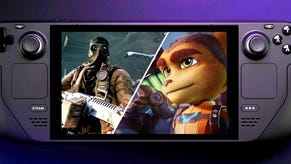DF Weekly: How will Ratchet and Clank PC handle the PS5's SSD requirement?
Another highly scalable port from Nixxes?
A while back, I wrote a DF Direct Weekly blog explaining why Ratchet and Clank: Rift Apart's PC port is crucial for the future of the platform, and last week's official specs reveal is validation of sorts for that initial article. The game remains a highly important release for the PC format because it's the first game built from the ground up around PlayStation 5's solid-state storage and hardware decompression capabilities - and we now have confirmation that the port will be using DirectStorage, the Microsoft API designed to bring current-gen console-level storage performance to the PC platform.
What's interesting is how it's going to be deployed. GPU-driven DirectStorage is supported on Ratchet and Clank, the idea being that the decompressing the data from storage is handled by the graphics hardware rather than the CPU. However, it seems that the port will carry out internal bandwidth and compute benches on the fly - and then decide which PC component works best for the decompression tasks. So, for example, let's say you have a highly performant CPU like a Core i9 13900K, but you have a less capable graphics card. The game may decide that instead of using GPU resources, it'll switch to the thread-heavy CPU instead.
Either way, we can't wait to check this out for a bunch of reasons, but I personally believe it's going to be the decompression situation that's more important than the presence of the SSD itself. After all, I've already run Ratchet and Clank: Rift Apart on the absolute worst SSD money can buy for the PlayStation 5. The 250GB SN750 SE has under-spec read speeds, and no DRAM cache, yet plays the game just fine. I've even taped off pins on the drive to reduce its read speeds to 1.7GB/s and everything still worked OK. This suggests that it's the hardware decompression tech within the PS5 that is doing the heavy lifting - and it'll be interesting to see how both CPU and GPU solutions handle the game.
- 00:00:00 Introduction
- 00:00:48 Ratchet & Clank: Rift Apart PC requirements drop
- 00:29:11 Halo cut content returning to Master Chief Collection
- 00:35:40 X68000 Mini retro device has issues
- 00:38:26 Limited Run Games shows off new and old titles
- 00:47:02 Leaked document details Sega of America’s struggles
- 01:05:40 What's up with the new HDMI 2.1 capture cards? And can’t PCs record 4K120 internally?
- 01:12:10 Does console software receive system-wide performance boosts over the course of a generation?
- 01:15:42 Why has Nvidia, besides the Switch, checked out of consoles?
- 01:23:24 Why was the Digital Foundry Twitter account in a Twitter Spaces event on UFOs?
- 01:26:32 Do you have plans for more conference commentary videos?
At this point, it's worth lauding developer Nixxes for actually delivering a recommended PC specification list that is actually useful. It's highly annoying when lists come our way featuring a range of hardware for minimum and recommended specs, only to be provided with no crucial context whatsoever - such as what the target resolution and frame-rate is, and at what settings. Without this, the spec list is pointless. In stark contrast, Nixxes supplies a range of kit recommendations for a range of settings, along with a ballpark resolution and performance level you should be able to get. It's the way it should be. There are even recommendations for upscaling on the higher end RT settings and remember, Nixxes has a policy of supporting all good upscaling solutions across all vendors - again, the way it should be.
What is surprising many is that at the absolute low-end, it is possible to run Ratchet and Clank without an SSD, even though it's still recommended. This has led some to believe that prior claims from Insomniac that the game couldn't work without the PS5 SSD are erroneous - but I think it's fairly safe to say that the game as delivered on PS5 won't work on a mechanical hard drive. It's all about scalability, something that Nixxes values highly in its ports - the idea of making these games as accessible as possible across a range of kit. Of course, the experience you'll get on the very low preset won't look much like the PlayStation 5 game - that should go without saying - but at least there'll be fallbacks for those without high-end rigs. And it's not just about storage: the min spec GPU is the Nvidia GeForce GTX 960, which typically only ships with 2GB of memory. I've got to check that out to see how that looks. And yes, we will be checking out the complete min spec experience at launch in our review content as it seems I have all the required components.
The specs reveal experience for Ratchet and Clank is somewhat at odds with AMD's latest marketing misfire with its Starfield partnership. Last week, bizarre recommended specs were announced by AMD that are entirely at odds with the minimum and recommended kit specified by Bethesda itself on its Steam page. The developer says that Ryzen 5 2600X or Ryzen 5 3600X are good enough for Starfield, whereas AMD's marketing is positioning the Ryzen 5 7600 as 'perfect entry specs' for a 'heroic' 1080p experience. Let's be clear here, the Ryzen 5 7600 is an absolutely superb mainstream CPU. However, I've noted games where that chip is twice as fast as Bethesda's recommendation, which has led to some degree of fear and panic on social media. What settings and performance targets are AMD specifying here? We don't know, because it's not stated. Marketing masquerading as recommended specs? This is not good.
In combination with AMD's non-denials about contractually blocking competing upscaling technologies from appearing in Starfield, this is a really bad look for Team Red on what is one of the most eagerly awaited games of the year. Why not concentrate on the positives of the partnership? I mean, bundle deals for Ryzen processors and RDNA GPUs that include a free copy of the game are obviously great for the customer, especially now when it's becoming clear that faster CPUs are required to run the latest games well. Why not focus on actual value and what's likely to be a really good deal on its own terms?
All of this accounts for just the first segment of the new DF Direct Weekly, embedded above. We're also talking about cut Halo content arriving in The Master Chief Collection, whlie John Linneman goes nuts over the massive Sega of America docs leak. I reveal the results of my first experiments with the world's first HDMI 2.1 capture card, showing some 120fps native 4K capture from Ori and the Will of the Wisps. There's also a bunch of great questions from our supporters, so once again, I urge you to check out our Supporter Program - become a part of a positive, engaged community, get early access and a bunch of bonus material and much more. In fact, I'm on the final hours of completing a major new DF project that was only possible because of input from our community - watch out for that later in the week. In the meantime, here's a teaser...





.jpg?width=291&height=164&fit=crop&quality=80&format=jpg&auto=webp)





